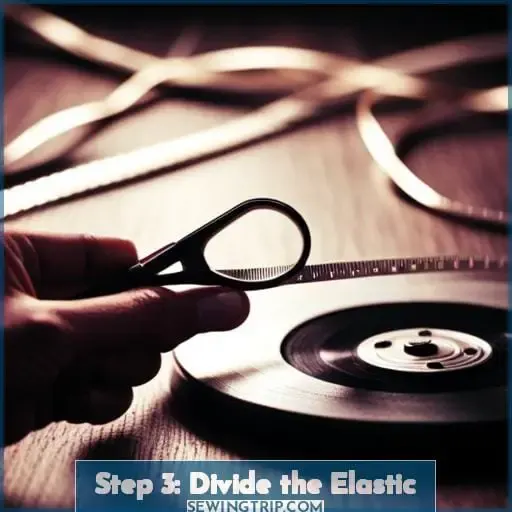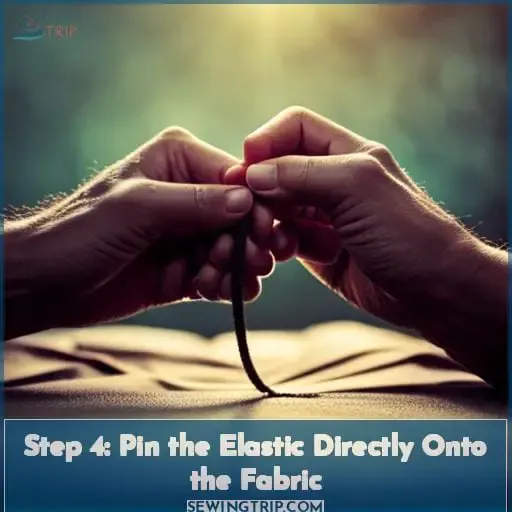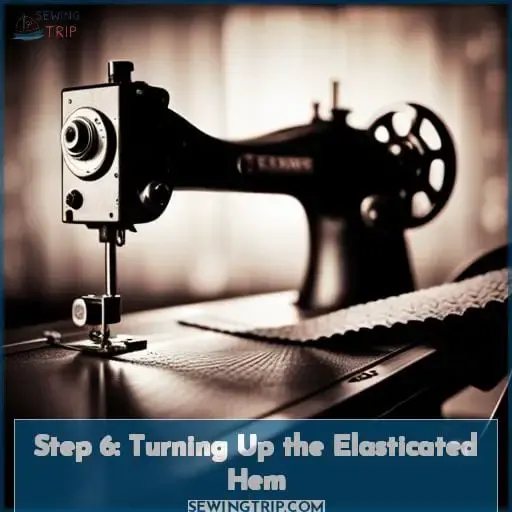This site is supported by our readers. We may earn a commission, at no cost to you, if you purchase through links.
 Ready to take your sewing skills to the next level? Learn how to sew elastic in easy steps and unlock a world of possibilities for your garments.
Ready to take your sewing skills to the next level? Learn how to sew elastic in easy steps and unlock a world of possibilities for your garments.
Whether you’re creating a comfortable waistband or adding gathers for an elegant touch, mastering elastic sewing techniques is essential. In this guide, we’ll walk you through the process with clear instructions and helpful tips.
Table Of Contents
- Key Takeaways
- What You’ll Need
- Step 1: Take Your Measurements
- Step 2: Prepare the Elastic
- Step 3: Divide the Elastic
- Step 4: Pin the Elastic Directly Onto the Fabric
- Step 5: Sewing the Elastic Directly Onto Fabric
- Step 6: Turning Up the Elasticated Hem
- Let’s Start With the Basics: What Types of Elastic Are There?
- Which Needle Should You Use to Sew With Elastic?
- Frequently Asked Questions (FAQs)
- Conclusion
Key Takeaways
- Elastic sewing requires fabric, elastic, a sewing machine, thread, fabric scissors, a tape measure, and pins.
- Taking accurate measurements is important before starting the elastic sewing project.
- Prepare the elastic by dividing it into two equal sections and overlapping the ends slightly.
- Pin the elastic directly onto the fabric by overlapping the ends and sewing them with multiple passes of a zigzag stitch.
What You’ll Need
To sew elastic, you’ll need:
- Fabric or an existing project
- Elastic
- A sewing machine
- Thread
- Fabric scissors
- A tape measure
- Pins
These tools are essential for successfully sewing elastic onto your garments.
The fabric serves as the base material that you’ll be attaching the elastic to.
Elastic provides stretch and helps create shape and gather in your garment.
A sewing machine is necessary for stitching the elastic securely in place with precision.
Thread is used to sew the stitches that hold everything together.
Fabric scissors are needed to cut both your fabric and elastic accurately without fraying or damaging them.
A tape measure ensures accurate measurements while pins help keep fabrics aligned during sewing tasks such as gathering or hemming with elastics.
Step 1: Take Your Measurements
You’ll need to measure yourself or the garment using a tape measure. This step is crucial in ensuring that you have the correct measurements for your elastic.
Here are three key things to remember when taking your measurements:
- Measure around your waist: Wrap the tape measure around your natural waistline, which is usually located at the narrowest part of your torso.
- Determine how tight or loose you want it: Consider whether you prefer a snug fit or a looser feel before selecting the size of elastic.
- Double-check for accuracy: Take multiple measurements and compare them to ensure they’re consistent.
By following these steps, you can be confident that you’ll use an appropriate-sized elastic and achieve optimal comfort when sewing it onto fabric later on.
Step 2: Prepare the Elastic
Now that you’ve taken your measurements with precision, it’s time to move on to the next step: preparing the elastic.
To ensure successful sewing, it’s crucial to use a stretch needle and avoid damaging the elastic during this process.
When making casings, remember to add an extra 5mm of ease for comfortable wear.
If you’re creating a waistband, start by joining the ends of the elastic together before attaching it to your garment.
For more gathering effect when using shirring elastic, set a longer stitch length on your machine.
And if you’re working with clear elastic or want smooth sewing without sticking issues, consider using a Teflon foot for optimal results.
Step 3: Divide the Elastic
Next, divide the elastic into two equal sections. This step is crucial to ensure that your elastic will be evenly distributed when sewn onto your fabric. By dividing the elastic, you create two separate pieces that can be easily attached to each side of the waistband or casing.
To do this, simply overlap one end of the elastic with the other, making sure they’re aligned perfectly. Pinch and hold both ends together firmly before proceeding to sew them in place using a zigzag stitch on your sewing machine.
Once divided and secured, you’re ready to move on to Step 4: Pinning and Sewing the Elastic Casing!
Step 4: Pin the Elastic Directly Onto the Fabric
To pin the elastic directly onto your fabric, start by placing the fabric and elastic together in their desired positions.
Overlap the ends of the elastic slightly to ensure a secure attachment.
Use pins to hold the seam of the elastic to one side of your fabric and repeat on all sides.
This will help keep everything in place while you sew.
When sewing, make sure to use a zigzag stitch setting on your machine for added durability and flexibility.
Be cautious not to stretch or damage the elastic as you sew it onto your fabric.
By following these steps, you’ll be able to securely attach your elastic without compromising its quality or functionality.
Once you have pinned down all sides of the elastic, you can begin sewing.
Step 5: Sewing the Elastic Directly Onto Fabric
Sew the elastic directly onto the fabric using a zigzag stitch. This step is crucial in securing the elastic and ensuring a comfortable fit for your garment.
Start by overlapping the ends of the elastic by about 0.25 inches to 0.5 inches, then use a safety pin to hold them together while you sew them with multiple passes of a zigzag stitch on your sewing machine.
Next, it’s time to attach the elastic to your fabric. Begin by pinning one end of the seam where you just sewed onto one side of your fabric band, and do this for both opposing sides as well.
Now, set up your sewing machine with its zigzag stitch setting and start sewing along the top edge of the elastic until it’s securely attached to all sides of your fabric band.
Once finished, give it a gentle tug on each side to ensure that all parts are under control before closing any casings or hems remaining from previous steps – close these openings if needed!
Step 6: Turning Up the Elasticated Hem
Now that you have successfully sewn the elastic directly onto your fabric, it’s time to move on to the next step: turning up the elasticated hem. This is an important step as it ensures a clean and professional finish for your garment.
- Pull gently on the fabric above and below the sewing line where you attached the elastic.
- Use a zigzag stitch setting on your sewing machine to create flexibility in both fabric and elastic.
- Measure and fold over 1 inch (2.5cm) of fabric towards the inside, creating a casing.
- Securely pin or clip along this folded edge to hold it in place while you work.
- Sew a straight stitch close to folded edge, about 0.25 inches (0.64cm) away from edges of fabric.
By following these steps, you’ll be able to effortlessly turn up your elasticated hem with precision and ease!
Let’s Start With the Basics: What Types of Elastic Are There?
Let’s start by discussing the basics:
- Flat elastic and shirring elastic are two common types used in sewing.
- Flat elastic is strong and thick, making it ideal for waistbands.
- Shirring elastic is perfect for gathering fabric as it can be wound onto the bobbin.
Understanding these different types of elastic will help you choose the right one for your sewing project.
Flat Elastic
Now let’s explore the different types of flat elastic that you can use for sewing projects.
Here are three common types of flat elastic:
| Type | Description |
|---|---|
| Woven Elastic | Strong and thick, perfect for waistbands |
| Clear Elastic | Transparent and used to stabilize stretchy seams |
| Elastic Thread | Sewn onto fabric to create shirring or gathering effect |
When working with flat elastic, remember to:
- Keep it taut while sewing.
- Overlap the ends before stitching them together using a zigzag stitch.
- Avoid stretching it too much.
If you’re using clear elastic, consider using a Teflon foot on your sewing machine to prevent sticking.
Shirring Elastic
To sew shirring elastic, gather the necessary materials and follow a few simple steps.
- Determine the desired length of shirring elastic based on your project.
- Use a zigzag stitch to sew the elastic onto fabric or create casings for it.
- When gathering with shirring elastic, wind it onto the bobbin at the right tension and use a longer stitch length for more gathers.
- Sewing shirring elastic to a waistband is easy when you overlap and stitch its ends inside the casing.
Which Needle Should You Use to Sew With Elastic?
When sewing with elastic, it’s important to use the right needle for optimal results.
The type and size of needle you choose can make a big difference in how well your elastic sews onto fabric.
For sewing stretchy materials like elastic, a stretch needle is recommended.
This type of needle has a slightly rounded point and is designed specifically for fabrics that require extra give and elasticity.
It helps prevent skipped stitches or broken threads while ensuring smooth stitching through the elastic without causing any damage to its structure.
When selecting thread for sewing with elastic, consider using polyester or nylon thread as they offer good strength and flexibility to withstand stretching without breaking easily.
Frequently Asked Questions (FAQs)
How do I determine the width of the casing for the elastic?
To determine the width of the casing for your elastic, measure the width of your elastic band.
Add 5mm to this measurement to allow for ease when making casings. This will ensure a comfortable and secure fit.
Can I use a straight stitch instead of a zigzag stitch when sewing the elastic to the fabric?
Using a straight stitch to sew elastic is like using a single thread to hold together the pieces of your power suit.
Stick with the zigzag stitch for maximum strength and endurance.
What type of elastic should I use for a waistband?
For a waistband, choose woven elastic for strength and thickness.
Braided elastic is affordable for lightweight casings.
Knitted elastic is soft and versatile to sew directly onto fabric.
How do I join the ends of the elastic when making a waistband?
To join the ends of your elastic when making a waistband,
- overlap them slightly by about 25 inches to 5 inches
- Sew a zigzag stitch over the overlapping area.
This ensures that your elastic stays securely in place for a comfortable fit.
Is it necessary to stretch the elastic before cutting it?
Yes, it’s necessary to stretch the elastic before cutting it. This helps prevent overstretching and ensures a snug fit.
Stretching the elastic slightly will also help maintain its elasticity over time.
Conclusion
To sew elastic like a pro, you’ll need to:
- Gather your supplies
- Take accurate measurements
- Prepare the elastic
These easy steps will unlock a world of possibilities for your garments, allowing you to create comfortable waistbands and elegant gathers. With a little practice and the right techniques, you’ll be able to confidently sew elastic in no time.
So grab your sewing machine and get ready to unleash your creativity with this essential skill.















